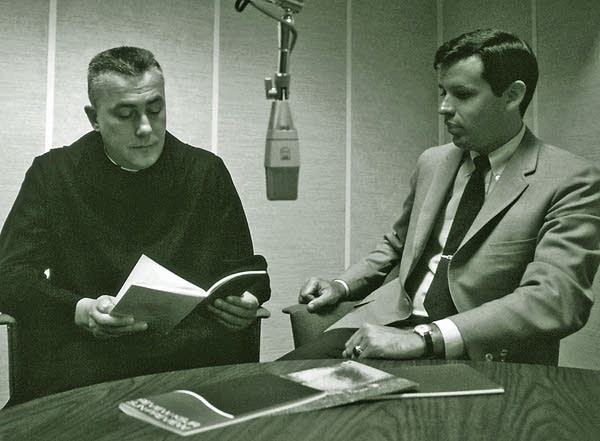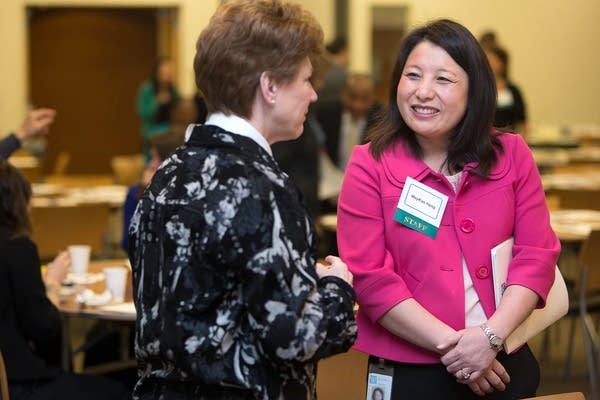MPR at 50: Looking back at Minnesota's past, ahead to its future

Go Deeper.
Create an account or log in to save stories.
Like this?
Thanks for liking this story! We have added it to a list of your favorite stories.
MPR marks 50 years
• More stories from the archives
• Join the celebration, tell us your story
Minnesota Public Radio first went on the air 50 years ago with a radio station on the campus of St. John's University in Collegeville, Minn. On Sunday, Jan. 22, MPR News marked the occasion with a two-hour broadcast exploring Minnesota's past 50 years — and its next 50.
Turn Up Your Support
MPR News helps you turn down the noise and build shared understanding. Turn up your support for this public resource and keep trusted journalism accessible to all.
In the beginning: Radio in the Benedictine tradition

Fifty years ago today, a small crew of individuals were feverishly preparing to put KSJR-FM, the first station in what would become the MPR network, on the air.
KSJR is still on the air, still located on the campus of St. John's University in Collegeveille. And that radio station would not have been created without the vision of one man: The Rev. Colman Barry. He was a monk in the Benedictine monastery that supports St. John's, and was president of the university from 1964 to 1971. He died in 1994.
In a 1992 interview, he said he wanted St. John's to get into broadcasting for the exposure it would bring. He was concerned that private colleges were being overshadowed by public institutions, like the University of Minnesota.
St. John's had had a radio station decades earlier — in the 1920s — and Barry thought the experiment could be repeated.
"I said, well if we can't do television, if we got radio, we would be in contact with the public. Our existence would be known," Barry said in a 1992 interview. "Sheer existence and presence. That was the purpose. It was very pragmatic. At the same time, we wanted the highest quality fine arts, music, good news, 24 hours, all of that."
Bill Kling, who worked with Barry in those early years to create Minnesota Public Radio when he was a physics major at St. John's, was president of Minnesota Public Radio from its start in 1967 until he retired in 2011. He joined MPR News host Cathy Wurzer to talk about those early years with Barry.
"He talked about how, traditionally, Benedictines were the center of culture in their communities," Kling said. "The monastery always had poets and writers and musicians who were on retainer, so to speak, and that's where culture 1,500 years ago came through to the community.
"And he said, we can't afford that anymore. We couldn't afford to have an orchestra, we couldn't afford to have poets who were just sitting and writing poetry. But, he said, we could do it through the radio, to all of the people of this region."
It took about a year to bring the radio to the region — with studios built by monks who were also carpenters and designed, in part, by Kling himself.
— Cathy Wurzer | St. Paul
Reflections from one of MPR's first hires: Gary Eichten

The first thing heard on what would become Minnesota Public Radio was classical music, and it has always been an important component of the service, but building a strong news department was also a part of the vision from the start.
One of the first people to be hired by Minnesota Public Radio was 20-year-old Gary Eichten. But Eichten had no designs at the time on being a broadcast journalist — he wanted to be a rock'n'roll disc jockey.
Eichten spoke with MPR News host Cathy Wurzer about one of the first major interviews he did for MPR — with Sen. Eugene McCarthy, who had made a short retreat at St. John's in the summer of 1968. He didn't understand the magnitude of the encounter at the time, Eichten said, but the interviews continued, well into Eichten's years as host of MPR's Midday show and beyond.
— Cathy Wurzer | St. Paul
Voices from St. Stephen: Hoping for change

Central Minnesota showed strong support for Donald Trump in the 2016 election. In Brockway Township, just a few miles from Collegeville in Stearns County, Trump broung in 75 percent of the vote.
MPR News reporter Jim Bickal visited the town of St. Stephen, situated in the midst of Brockway Township, to speak with residents about their hopes for a Trump administration.
St. Stephen is believed to be the oldest Slovenian settlement in the United States, and many of its roughly 850 residents are descendents of early Slovenian settlers.
Former mayor — and lifelong St. Stephen resident — Bill Vouk told Bickal he wasn't surprised at Trump's showing in the community. "I think the major reason is this is pretty much a Catholic area and we do have pretty much rigid moral values and I think the abortion issue really affected that," Vouk said.
Besides abortion, the most common explanation Vouk's neighbors offer in explaining Trump's victory is a desire for change: In trade regulations, in America's place as a world power, in the military, in health care, in public safety and in immigration.
"The U.S. is the strongest country in the world, and I think it's high time we act like it again," Vouk said. "If you've got power you should be able to use that power, hopefully for good for everybody. But I hope that's one of the changes that will come in."
— Jim Bickal | St. Stephen, Minn.
Rep. Tom Emmer: Trump "was talking to the forgotten men and women in this country"

U.S. Rep. Tom Emmer, who represents Minnesota's 6th Congressional District in the House of Representatives, joined MPR News host Cathy Wurzer.
Emmer reflected on the heavy support for President Trump in his district, which stretches from the Twin Cities' northern suburbs of Hugo, Lino Lakes and Ramsey to just beyond St. Cloud in Stearns and Benton counties and south to Waconia and Norwood.
"He was talking to the forgotten men and women in this country and, I think, in the district that I represent, and in fact in St. Stephen, Minn., and the surrounding areas," Emmer said. "Those are the people he was talking to: People who feel like the political elites in this country, the establishment ... had been patting them on the head and telling them, 'Hey, there's nothing to see here, folks. It's all good, we got it' — and things haven't improved."
— Cathy Wurzer | St. Paul
Minnesota: A state built by immigrants

In the late 1800s and early 1900s, immigration peaked in Minnesota, as newcomers from Sweden, Norway, and Germany flooded into the state.
But by the time Minnesota Public Radio began in 1967, experts say the number of new Americans settling here had bottomed out.
The issue of immigration has been front and center through last year's election campaign, and it's been a growing issue for Minnesota, especially in the 50 years MPR News has been on the air.
With a more recent influx of newcomers from East African, Asian and Latin American countries, immigration — and the social, political, economic and identity questions it brings with it — is again at the fore.
Along the way, MPR News' reporting has taken the long view, sometimes reflecting on how some of the issues that seem so fresh and raw now, actually began decades earlier.
In 1979, MPR News sent reporters Greg Baron and Bob Aronson to Thailand, to tell us about the conditions Cambodians coming to Minnesota were facing on their way to the United States. Decades later, in 2010, reporter Liz Baier looked at the ways immigration changed the meat-packing city of Austin, Minn., — 25 years after Hormel prevailed in one of the longest labor strikes in the 1980s.
There are hundreds of thousands of immigrant stories here in Minnesota. No two are alike — but we invited three people who have lived that experience to share their Minnesota immigrant experience with us:
• Kao Kalia Yang, a writer and author of "The Song Poet" and "The Latehomecomer: A Hmong Family Memoir," which won two Minnesota Book Awards
• Fardousa Jama, founder of the Somali Community Barwaaqo Organization in Mankato, who works to find jobs for Somali and other immigrants
• Dante Pastrano, an instructor in Krav Maga self-defense, and a 911 service technician for for Century Link, was born in the Dominican Republic and naturalized in Puerto Rico
In a thoughtful, robust and challenging discussion about what it means to be Minnesotan — and American — in 2017, the group talked about the subtle — and blatant — racism they've encountered in their everyday. They talked about the things they love about Minnesota — and the things they wish people whose immigration stories go back a little further would recognize about the common ground we all share.
— Tom Crann | St. Paul
Ely: The much-loved town "that refuses to be loved"

Ely is often described as a frontier town, a Dodge City type of place — a place that requires a special kind of person to live there.
"There are more stories per square inch in Ely than any place in the world," said National Geographic wildlife photographer Jim Brandenburg, who has made Ely his part-time home.
It's easy on first take to fall in love with the quirky side of Ely — the fun tourism campaigns about Ely bidding for the Olympics or the fact that every few years, the local license bureau can sell license plates that begin or end with ELY — but if you only hear these stories and smile at the aw-shucks quirkiness, you're not giving Ely its due.
It's considered by many to be the gateway to the Boundary Waters Canoe and Wildlife Area Wilderness, and a must-visit place of beauty and serenity atop Minnesotans' lists. But it's also got a complicated history of mining, regulations, insiders-outsiders and fierce independence, all of which have become as much a piece of Ely as the pristine wilderness that surrounds it.
One longtime resident and local radio personality "always described Ely as a town that refuses to be loved," Brandenburg said. "Amazing dynamics. It comes out as anger a lot — and we see it. It's hard to be around it sometimes."
But how can Ely be "hard to be around" when so many people across the state find Ely a place they "have to be around?"
— Tom Weber | Ely, Minn. | More on this story
To the phones: How do we think about who we are?

We couldn't celebrate and observe this milestone of 50 years on the air without talking to Minnesotans.
"We tell ourselves a story about who we are," MPR News host Kerri Miller said, "and there are changes that are pushing up against that story that we tell ourselves, and we're in this moment of trying to encompass what those changes mean to our self-identity."
As our community and our region changes, What does it mean to be a Minnesotan now? And how will we — and must we — change over the next few decades?
"We are more diverse than ever, in terms of race and ethnicity," said Wilder Foundation President and CEO MayKao Hang, "but who we think we are and what we want to become and who we are, in fact, right now ... is very different. And different can be scary."
Hang and Miller talked to Minnesotans live on the air about who we are and where we're going.
— Kerri Miller | St. Paul


